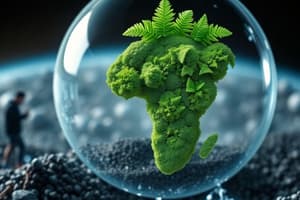Podcast
Questions and Answers
What term describes the amount by which resource demands exceed Earth’s supply?
What term describes the amount by which resource demands exceed Earth’s supply?
- Ecological Overshoot (correct)
- Sustainable Development
- Resource Depletion
- Ecological Footprint
Which of the following actions is NOT a solution to promote resource sustainability?
Which of the following actions is NOT a solution to promote resource sustainability?
- Increasing consumption of single-use plastics (correct)
- Reusing and recycling materials
- Reducing waste and pollution
- Being conscious of water and energy usage
What percentage of the global population is responsible for consuming 80% of the Earth’s resources?
What percentage of the global population is responsible for consuming 80% of the Earth’s resources?
- 20% (correct)
- 30%
- 50%
- 10%
Primary industries contribute to the economy mainly by:
Primary industries contribute to the economy mainly by:
Which of the following is NOT included in the aspects that contribute to one's ecological footprint?
Which of the following is NOT included in the aspects that contribute to one's ecological footprint?
Which of the following accurately describes tertiary industries?
Which of the following accurately describes tertiary industries?
What energy source accounts for the largest percentage of Canada’s electricity generation?
What energy source accounts for the largest percentage of Canada’s electricity generation?
Which method is used to extract bitumen from oil sands when they are deeper than 75 m?
Which method is used to extract bitumen from oil sands when they are deeper than 75 m?
What is true about unconventional energy sources?
What is true about unconventional energy sources?
What percentage of Canada’s electricity generation does biomass represent?
What percentage of Canada’s electricity generation does biomass represent?
Which of the following statements is incorrect regarding oil sands?
Which of the following statements is incorrect regarding oil sands?
Which aspect of the Trans Mountain Pipeline is accurate?
Which aspect of the Trans Mountain Pipeline is accurate?
What is a major challenge associated with in-situ extraction of bitumen?
What is a major challenge associated with in-situ extraction of bitumen?
Which of the following is NOT considered a renewable energy source?
Which of the following is NOT considered a renewable energy source?
Which of these energy sources contributes the least to Canada’s electricity generation?
Which of these energy sources contributes the least to Canada’s electricity generation?
Flashcards
Natural Resource
Natural Resource
Parts of the environment that provide usable goods and services (like air, water, plants, and minerals).
Ecological Footprint
Ecological Footprint
A measure of how much resources we use and waste we create.
Ecological Overshoot
Ecological Overshoot
Using more resources than Earth can replace.
Primary Industry
Primary Industry
Signup and view all the flashcards
Sustainability
Sustainability
Signup and view all the flashcards
Tertiary Industries
Tertiary Industries
Signup and view all the flashcards
Quaternary Industries
Quaternary Industries
Signup and view all the flashcards
Conventional Energy
Conventional Energy
Signup and view all the flashcards
Alternative Energy
Alternative Energy
Signup and view all the flashcards
Unconventional Energy
Unconventional Energy
Signup and view all the flashcards
Oil Sands
Oil Sands
Signup and view all the flashcards
Hydroelectricity
Hydroelectricity
Signup and view all the flashcards
Trans Mountain Pipeline
Trans Mountain Pipeline
Signup and view all the flashcards
Surface Mining (Oil sands)
Surface Mining (Oil sands)
Signup and view all the flashcards
In-situ Oil Sands Extraction
In-situ Oil Sands Extraction
Signup and view all the flashcards
Study Notes
Resource Sustainability
- Natural Resource: Components of the environment, providing goods and services (air, sunlight, water, land, vegetation, animals, geological resources).
- Ecological Footprint: A measurement (hectares) calculating human impact on resources, considering consumption, waste, and pollution.
- Ecological Overshoot: The extent to which resource demands exceed Earth's supply.
- Sustainability: Meeting present needs without compromising future generations' ability to meet their needs.
- Solutions/Actions: Reducing waste, reusing/recycling/repurposing, conserving water/energy, limiting plastics, and using reusable items.
- Footprint Factors: Energy use, housing area, product resources, food production land, and waste disposal areas all make up an individual's ecological footprint.
- Resource Inequality: About 20% of the global population consumes roughly 80% of Earth's resources.
Types of Industries
- Industry: Economic activity processing raw materials and producing goods/services.
- Primary Industries: Extract raw materials (mining, agriculture, forestry, fishing, oil/gas). Contribute 6% of Canada's total goods and services.
- Secondary Industries: Manufacturing and construction, using primary industry resources (auto manufacturing, food processing).
- Tertiary Industries: Offer services (retail, transportation, entertainment, healthcare, banking, education).
- Quaternary Industries: Focused on ideas (research, development, ICT, management, scientific research).
Energy Resources in Canada
- Conventional Energy: Fossil fuels (oil, gas, coal), nuclear. Cost-effective, accessible, high output. Pollute, non-renewable, produce radioactive waste.
- Alternative Energy: Renewable sources (solar, wind, tidal, geothermal, biomass, hydro). Clean burning, environmentally friendly.
- Unconventional Energy: Hydraulic fracturing (fracking) to extract oil/gas from shale formations.
- Main Energy Uses: Industry, agriculture, transportation, residential, commercial, institutional.
- Renewable Energy in Canada: Hydro is the dominant renewable energy source (59.3% of electricity generation). Followed by wind (3.5%). Biomass (1.4%). Wind and solar are growing fastest.
Oil Sands & TMX
-
Trans Mountain Pipeline: Transports crude oil and petroleum from Edmonton to Vancouver (transferred to other countries as well).
-
Alberta Oil Sands: Lake Athabasca, Peace River, Cold Lake. Sources of bitumen.
-
Surface Mining: Extracts oil sands near surface. Uses heavy machinery, then processes to separate bitumen.
-
In-Situ Extraction: Extracts bitumen from deeper deposits. More costly, less disruptive to the land surface, but higher greenhouse gas emissions than surface mining. This method involves pumping solutions to force the bitumen to the surface.
-
Oil Sands Characteristics: Non-renewable. Bitumen processed for home, factory, vehicle fuels, and plastics.
-
Bitumen Removal: Heats freshwater (uses natural gas) to extract bitumen from sand. Water/sand mixture goes to tailing ponds (toxic due to oil residue).
Studying That Suits You
Use AI to generate personalized quizzes and flashcards to suit your learning preferences.
Description
Test your knowledge on sustainability concepts, ecological footprints, and resource management. This quiz covers topics like ecological overshoot and the importance of reducing waste. Additionally, assess your understanding of the various types of industries and their impact on resource consumption.




